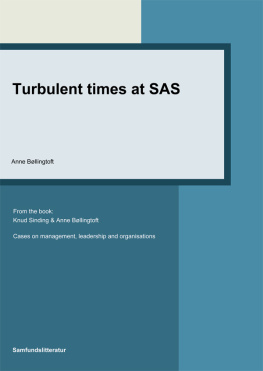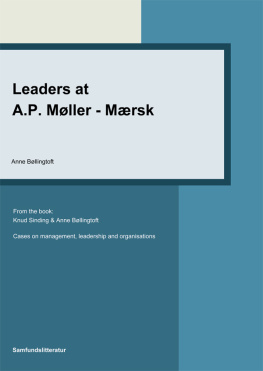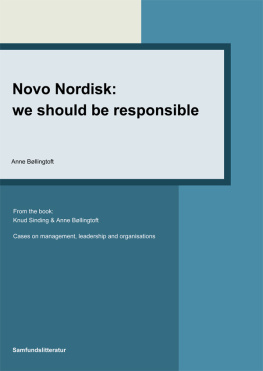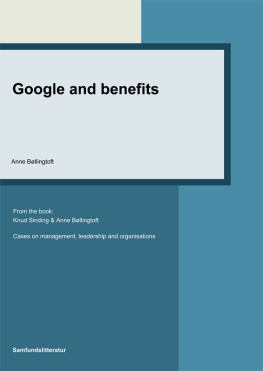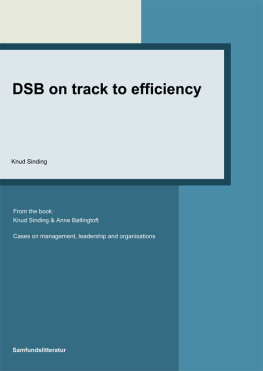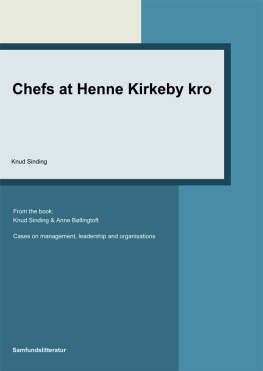Bøllingtoft - Turbulent times at SAS Cases on Management, Leadership and Organisations
Here you can read online Bøllingtoft - Turbulent times at SAS Cases on Management, Leadership and Organisations full text of the book (entire story) in english for free. Download pdf and epub, get meaning, cover and reviews about this ebook. City: Samfundslitteratur, year: 2013, publisher: Samfundlitteratur;Anne Bøllingtoft, Samfundslitteratur, genre: Business. Description of the work, (preface) as well as reviews are available. Best literature library LitArk.com created for fans of good reading and offers a wide selection of genres:
Romance novel
Science fiction
Adventure
Detective
Science
History
Home and family
Prose
Art
Politics
Computer
Non-fiction
Religion
Business
Children
Humor
Choose a favorite category and find really read worthwhile books. Enjoy immersion in the world of imagination, feel the emotions of the characters or learn something new for yourself, make an fascinating discovery.
- Book:Turbulent times at SAS Cases on Management, Leadership and Organisations
- Author:
- Publisher:Samfundlitteratur;Anne Bøllingtoft, Samfundslitteratur
- Genre:
- Year:2013
- City:Samfundslitteratur
- Rating:4 / 5
- Favourites:Add to favourites
- Your mark:
- 80
- 1
- 2
- 3
- 4
- 5
Turbulent times at SAS Cases on Management, Leadership and Organisations: summary, description and annotation
We offer to read an annotation, description, summary or preface (depends on what the author of the book "Turbulent times at SAS Cases on Management, Leadership and Organisations" wrote himself). If you haven't found the necessary information about the book — write in the comments, we will try to find it.
Bøllingtoft: author's other books
Who wrote Turbulent times at SAS Cases on Management, Leadership and Organisations? Find out the surname, the name of the author of the book and a list of all author's works by series.
Turbulent times at SAS Cases on Management, Leadership and Organisations — read online for free the complete book (whole text) full work
Below is the text of the book, divided by pages. System saving the place of the last page read, allows you to conveniently read the book "Turbulent times at SAS Cases on Management, Leadership and Organisations" online for free, without having to search again every time where you left off. Put a bookmark, and you can go to the page where you finished reading at any time.
Font size:
Interval:
Bookmark:
Anne Bllingtoft
Turbulent times at SAS

Anne Bllingtoft
Turbulent times at SAS
From the book:
Knud Sinding and Anne Bllingtoft
Cases on Management, Leadership and Organisations, 1st edition 2012, chapter 22
1st e-book chapter 2013
Samfundslitteratur 2012
Cover design: Klahr|Graphic Design
Typeset: SL grafik, Frederiksberg
E-book production: Rosendahls BookPartnerMedia
ISBN: 978-87-593-9521-9
Samfundslitteratur
Rosenoerns All 9
DK-1970 Frederiksberg C
Denmark
Tlf: + 45 38 15 38 80
Fax: + 45 35 35 78 22
www.samfundslitteratur.dk
All rights reserved.
No part of this publication may be reproduced or used in any form or by any means graphic, electronic or mechanical including photocopying, recording, taping or information storage or retrieval system without permission in writing from the publisher.
CHAPTER 22
TURBULENT TIMES AT SAS
At the beginning of the last century it was a commonly held view that the average persons goal and the companys goal were in conflict with one another by default. Today, its generally accepted that management and employees dont need to have conflicting goals. Yet how can it be that this isnt always reflected in the practice of companies today?
Since 2001, the airline industry has generally faced difficult conditions due to fluctuations in demand, increasing fuel prices and, since 2008, a severe financial crisis. Many airlines have had to merge with or have been taken over by stronger competitors, or they have gone bankrupt. Like many other airlines, SAS (Scandinavian Airline Systems) has fought a long and hard battle to survive. The implementation of a series of cost reduction measures has played a key role in this battle. Although the cost reduction measures have helped SAS get through turbulent periods and survive as an independent company, the price has often been employee strikes. This has resulted in declining customer confidence towards the company through the years, which has added to making the fight for survival even more challenging.
SAS was founded in 1946 in a merger of the three national airlines of Denmark, Norway and Sweden. Historically, the company was the pride of each of the three nations decades ago when most modern nations had a state-owned airline. In the eighties, SAS was considered to be the Businessmans Airline, while the company today and through a number of years has been sandwiched between the airline industrys top and bottom segment. Discount airlines have pressured SAS from below, while British Airways and other similar giants have pressured from above with offers of luxury seating and good service for the picky passengers. Every time SAS has a crisis there is talk in the media about a possible takeover by Lufthansa.
In 2007, the CEO Mats Jansson publicly announced a public business strategy called Strategy 2011. On that occasion he declared:
Unlike many airlines, we have come out stronger from the recent turmoil. Many big European airlines have filed for bankruptcy or have been bought up or have merged, while new competitors have emerged on the scene. We have reduced our costs and improved our offers for customers. It has been tough, but we have made it and we are now on more solid ground. But our turnaround is not over yet. On the contrary, our journey has just begun.
Strategy 2011 was not developed in secret. Mats Jansson interviewed over 100 managers and employees, board members and union representatives precisely in connection with the development of Strategy 2011. This gave Jansson a clear picture of the challenges SAS faced.
To move forward
The intention was that Strategy 2011 would form the foundation for profitable growth, and, briefly outlined, it focused on:
Cultural turnaround through customer orientation and greater commitment
Focus on airline operations
Concentration on Northern Europe
Harmonisation and development of offers for customers
Competitiveness in all parts of the company
When Jansson introduced the future plan to the employees at SAS, he pointed out:
To succeed, we must dare to change. To succeed we need to continue to have the ability to change. We are obligated to implement the new cost reductions in their entirety, while improving customer service. Together we will succeed! In 2011 we will have a stronger SAS with greater customer loyalty and a customer oriented business culture with strong leadership and increased commitment. We will have improved competitiveness, which will make it possible for us to be at least 20 % bigger than today. Strategy 2011 will be our strength while we become an even better company for us as employees at SAS. The cost reductions will be implemented until 2009. The cuts will include production, sales and administration. We need to have a cultural turnaround characterised by a stronger customer orientation, clearer management and greater commitment among all of our employees. It requires, therefore, that both management and employees support our vision, business concept and strategy. We have to change our cultural core values and dare to question old truths. We must increase understanding and respect for our customers needs, demands and expectations. We are here to service our customers and not the other way around.
Janssons focus on cultural turnaround and the lack of a customer driven culture in Scandinavias largest airline was not coincidental. Actually, the strategy was presented somewhat later than originally planned, particularly due to strikes in the company. Throughout the previous months, SAS had lost several hundred million Danish Kroner due to strikes in Denmark and Sweden. Jansson had declared that he understood the staffs view on wages, training and work environment, but he added:
My point is that you dont solve that type of problem with a strike. Its unnecessary, worthless, flawed and counterproductive.
Jansson quickly spotted that a cultural shift in SAS was necessary when he informally started in the position of CEO for SAS in 2006. Later, he told a large business paper:
I quickly saw that we would never reach our financial goals if we didnt start by implementing a cultural turnaround. In the other companies I have worked for, the culture question was in fourth or fifth place. In SAS, it is at the very top.
Jansson was far from the only one who thought a cultural shift was necessary. The year Jansson officially took over as CEO for SAS, brand consultant, Claus Buhl, said to a large business newspaper that SASs brand seemed old-fashioned because the company was stuck in the past.
And the salary structure and unions make it difficult for SAS to manoeuvre. If the business strategy is to be the dominating airline for Scandinavians, then old planes and too-high prices obviously wont work. The additional price for an SAS-ticket should be justified by the trip itself, because it can no longer be justified by the name SAS.
The latter was said by Claus Buhl with reference to the fact that many SAS-planes had reached the end of their effective life and should be renewed. This would require financial latitude, which in turn required loyal customers and tranquillity within the company. Claus Buhl concluded:
Therefore, there is a need for a new alliance between the employees and management.
A new management philosophy
Beyond the strategy, Jansson also reconstructed the organisation to make managers more visible in SAS so that they could be in continuous dialogue with the employees. He emphasised to the managers:
This development requires a management style that is consistent, straightforward and reliable. Moreover, both management and the employee unions need to cooperate better. Strikes shouldnt be needed to solve problems. We need to develop a new cooperation model with the unions. Through continued dialogue between management, employees and unions, we will create a foundation for winning the battle for customers. We want to be proud to work at SAS. This pride is a big advantage. The challenge lies in combining pride with self-criticism and willingness to change.
Next pageFont size:
Interval:
Bookmark:
Similar books «Turbulent times at SAS Cases on Management, Leadership and Organisations»
Look at similar books to Turbulent times at SAS Cases on Management, Leadership and Organisations. We have selected literature similar in name and meaning in the hope of providing readers with more options to find new, interesting, not yet read works.
Discussion, reviews of the book Turbulent times at SAS Cases on Management, Leadership and Organisations and just readers' own opinions. Leave your comments, write what you think about the work, its meaning or the main characters. Specify what exactly you liked and what you didn't like, and why you think so.

